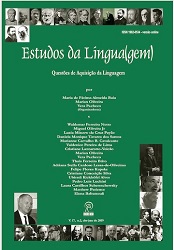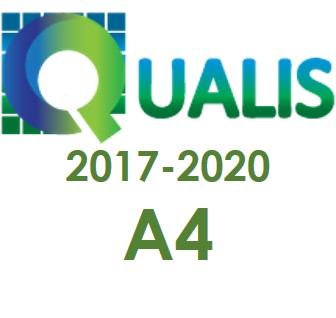Expressão emocional em pessoas com síndrome de Down: análise acústica da alegria e da tristeza (The emotional expression in Down syndrome people: acoustic analysis of happiness and sadness)
DOI:
https://doi.org/10.22481/el.v17i2.5337Palavras-chave:
Acústica; Curva melódica; Emoções; Síndrome de Down.Resumo
As emoções podem ser expressas pelos indivíduos em geral. A fala traz informações importantes sobre uma mensagem e pistas prosódicas auxiliam na compreensão do que está sendo dito. As pessoas com Down apresentam alterações no desenvolvimento global que implicam em dificuldades na linguagem e na comunicação. Este estudo visa analisar a fala alegre e triste, por meio da análise acústica da curva melódica de sentenças entoadas por sujeitos com e sem Down. Os dados mostraram que as pessoas com Down apresentaram diferenças na configuração melódica de pelo menos uma das emoções investigadas em comparação com os sujeitos sem Down.
Downloads
Referências
AUBERGÉ, V.; ANTUNES, L. B. Análise Prosódica da certeza e da incertezaem fala espontânea e atuada. Diadorim, Rio de Janeiro, v. 17, n. 2, p. 212-237, 2015.
BARBOSA, A. P. Conhecendo melhor a prosódia: aspectos teóricos e metodológicos daquilo que molda nossa enunciação. Revista de Estudos Linguísticos, vol. 20, n.1, p.11-27, 2012.
BOONE, D. A sua voz está traindo você? Porto Alegre: Artes médicas, 1996.
BOERSMA, Paul; WEENINK, David. Praat: Doing phonetics by computer. www.praat.org, 1996.
CAGLIARI, L. C. Prosódia: algumas funções dos supra-segmentos. Cadernos de Estudos Linguísticos: Fonologia do Português. (org. por Maria B. M. Abaurre & W. Leo Wetzels). Campinas: UNICAMP, IEL, DL. n. 23, p. 137-151, 1992.
DAMÁSIO, A. O Mistério da Consciência: do corpo e das emoções do conhecimento de si. São Paulo: Companhia das Letras, 2000.
DARWIN, C. R. The expression of the emotions in man and animals. London: John Murray, 1872.
EKMAN, P. An argument for basic emotions. Cognition and Emotion, Palo Alto, CA, v. 6, n. 3/4, p. 169-200, 1992.
FREITAS-MAGALHÃES, A. O código de Ekman: O cérebro, a face e a emoção Porto: FEE Lab Science Books, 2013.
LAUKKA, P. Vocal expression of emotion: Discrete-emotions and dimensional accounts. 2004. Tese (Doutorado). Uppsala, Sweden: Acta Universitatis Upsaliensis, v. 141. p. 1-80, 2004.
LOPES, L.W; LIMA, I. L. B. Prosódia e transtornos da linguagem: levantamento das publicações em periódicos indexados entre 1979 e 2009. Rev. CEFAC. v. 16, n. 2, 651-659, mar-abr, 2014.
MIGUEL, F. K. Psicologia da expressão emocional. Psico-USF, Bragança Paulista, v. 20, n. 1, p. 153-162, jan./abr. 2015.
OLIVEIRA, M. Questões de linguagem em sujeitos com síndrome de Down. Revista Prólíngua. v. 5 , n. 1 - jan/jul, 2010.
PIAGET, J.; INHELDER, B. De la Logiques de L Enfant à Logique de L Adolescent. Paris: PUF, 1955. [Da Lógica da Criança à Lógica do Adolescente. São Paulo: Pioneira, 1976].
RANGEL, D. I.; RIBAS, L. P. Características da linguagem na síndrome de Down: Implicações para a comunicação. Revista Conhecimento Online, Novo Hamburgo, v. 2, p. 18-29, set. 2011.
READ, A.; DONNAI, D. Genética clínica: uma nova abordagem. Porto Alegre: Artmed, 2008.
SCHERER, K.R. Vocal Affect signalling. Advances inthe study of behavior. New York: Academy Press, 1986.
SCHERER, K. R. Vocal communication of emotion: A review of research paradigms. Speech Communication, v. 40, n. 1-2, p. 227-256, 2003.
SHAWARTZMAN, J. S. Síndrome de Down. (org.) São Paulo: Memnon, 2013.
VASSOLER, A. M; MARTINS, M. V. A entoação em falas teatrais: uma análise da raiva e da fala neutra. Estudos Linguísticos, São Paulo, v. 42, n. 1, p. 9-18, jan-abr, 2013.
Downloads
Publicado
Como Citar
Edição
Seção
Licença
Autores que publicam em Estudos da Língua(gem) concordam com os seguintes termos:
Estudos da Língua(gem) mantém os direitos autorais das contribuições publicadas e disponibiliza seu conteúdo gratuitamente por meio do portal. Autores têm permissão e são estimulados a publicar e distribuir seu trabalho online em repositórios institucionais ou na sua página pessoal, com reconhecimento de autoria e créditos de publicação inicial nesta revista, indicando endereço online.












